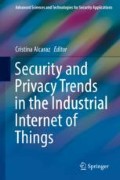Abstract
Some type of privacy-preserving transformation must be applied to any data record from Industrial Internet of Things (IIoT) before it is disclosed to the researchers or analysts. Based on the existing privacy models such as Differential Privacy (DP) and k-anonymity, we extend the DP model to explicitly incorporate feature dependencies, and to produce guarantees of privacy in a probabilistic form that generalize k-anonymity. We assume that additional (external) knowledge of these relations and models can be represented in the form of joint probability distributions, such as Mutual Information (MI). We propose an enhanced definition of DP in conjunction with a realisation for non-randomizing anonymizing strategies such as binning, reducing the extent of binning required and preserving more valuable information for researchers. This allows the formulation of privacy conditions over the evolving set of features such that each feature can be associated its own allowance for privacy budget. As a case study, we consider an example from the Industrial Medical Internet of Things (IMIoT). We have identified some challenges that are not completely addressed by existing privacy models. Unlike physiological measurements in conventional medical environments, IMIoT is likely to result in duplicate and overlapping measurements, which can be associated with different personally identifiable items of information. As an example, we present a model of sequential feature collection.
Access this chapter
Tax calculation will be finalised at checkout
Purchases are for personal use only
References
Darwish S, Nuretdinov I, Wolthusen S (2017) Towards composable threat assessment for medical IoT (MIoT). In: The Fourth International Workshop on Privacy and Security in Healthcare (PSCare17), vol 113, pp 627–632
Samaratiy P, Sweeney L (1998) Pierangela: protecting privacy when disclosing information: k-anonymity and its enforcement through generalization and suppression. Tech. Rep., SRI International
Dwork C, Roth A (2014) The algorithmic foundations of differential privacy. Found Trends Theor Comput Sci 9(3/4):211–407. https://doi.org/10.1561/0400000042
Darwish S, Nuretdinov I, Wolthusen S (2018) A dynamic distributed architecture for preserving privacy of medical IoT monitoring measurements. In: 16th International Conference on Smart Homes and Health Telematics (ICOST’2018), pp 106–115
Vovk V (2006) Well-calibrated predictions from on-line compression models. Theor Comput Sci 364(1):10–26. https://doi.org/10.1016/j.tcs.2006.07.038
Duncan G (2006) Statistical confidentiality: is synthetic data the answer?. https://web.archive.org/web/20060905115447/http://www.idre.ucla.edu/events/PPT/2006_02_13_duncan_Synthetic_Data.ppt
Dalenius T, Reiss SP (1982) Data-swapping: a technique for disclosure control. J Stat Plann Inference 6(1):73–85
Reiter J (2004) Simultaneous use of multiple imputation for missing data and disclosure limitation. Surv Methodol 30:235–242
HESA (2017) Rounding and suppression to anonymise statistics. https://www.hesa.ac.uk/about/regulation/data-protection/rounding-and-suppression-anonymise-statistics
Lin Z, Hewett M, Altman RB (2002) Using binning to maintain confidentiality of medical data. In: Proceedings of AMIA Symposium, pp 454–8
Lee Y, Band H, Kim DJ (2016) How to establish clinical prediction models. Endocrinol Metab 31:38–44
Kattan MW (ed) (2009) Encyclopedia of medical decision making. https://doi.org/10.4135/9781412971980
Zagorecki A, Orzechowski P, Holownia K (2013) A system for automated general medical diagnosis using bayesian networks. In: MEDINFO 2013 – Proceedings of the 14th World Congress on Medical and Health Informatics, 20–13 Aug 2013, Copenhagen, pp 461–465. https://doi.org/10.3233/978-1-61499-289-9-461
Franklin SS, Khan SA, Wong ND, Larson MG, Levy D (1999) Is pulse pressure useful in predicting risk for coronary heart disease? Circulation 100(4):354–360. https://doi.org/10.1161/01.CIR.100.4.354. http://circ.ahajournals.org/content/100/4/354
Li N, Li T, Venkatasubramanian S (2007) t-closeness: privacy beyond k-anonymity and l-diversity. In: 2007 IEEE 23rd International Conference on Data Engineering, pp 106–115. https://doi.org/10.1109/ICDE.2007.367856
Hadian M, Liang X, Altuwaiyan T, Mahmoud MMEA (2016) Privacy-preserving mHealth data release with pattern consistency. In: IEEE Global Communications Conference, pp 1–6
Liu C, Chakraborty S, Mittal P (2016) Dependence makes you vulnerable: differential privacy under dependent tuples. In: Network and Distributed System Security Symposium
Malekzadeh M, Clegg RG, Haddadi H (2017) Replacement autoencoder: a privacy-preserving algorithm for sensory data analysis. CoRR abs/1710.06564. http://arxiv.org/abs/1710.06564
Liese F, Vajda I (2006) On divergences and informations in statistics and information theory. IEEE Trans Inf Theory 52(10):4394–4412. https://doi.org/10.1109/TIT.2006.881731
Cuff P, Yu L (2016) Differential privacy as a mutual information constraint. In: Proceedings of the 2016 ACM SIGSAC Conference on Computer and Communications Security (CCS’16), pp 42–54
Acknowledgements
This work was supported by Technology Integrated Health Management (TIHM) project awarded to the School of Mathematics and Information Security at Royal Holloway as part of an initiative by NHS England supported by InnovateUK. It was also supported by European Union grant 671555 (“ExCAPE”) and AstraZeneca grant “Machine Learning for Chemical Synthesis” (R10911).
Author information
Authors and Affiliations
Corresponding author
Editor information
Editors and Affiliations
Rights and permissions
Copyright information
© 2019 Springer Nature Switzerland AG
About this chapter
Cite this chapter
Darwish, S., Nouretdinov, I., Wolthusen, S. (2019). Modelling the Privacy Impact of External Knowledge for Sensor Data in the Industrial Internet of Things. In: Alcaraz, C. (eds) Security and Privacy Trends in the Industrial Internet of Things. Advanced Sciences and Technologies for Security Applications. Springer, Cham. https://doi.org/10.1007/978-3-030-12330-7_11
Download citation
DOI: https://doi.org/10.1007/978-3-030-12330-7_11
Published:
Publisher Name: Springer, Cham
Print ISBN: 978-3-030-12329-1
Online ISBN: 978-3-030-12330-7
eBook Packages: Computer ScienceComputer Science (R0)

